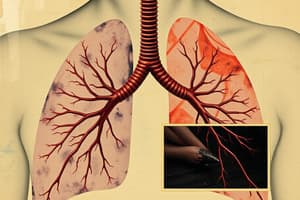Podcast
Questions and Answers
What is atelectasis?
What is atelectasis?
- Collapse of alveolar air spaces (correct)
- Expansion of alveolar air spaces
- Constriction of bronchial tubes
- Increase in lung capacity
When is supplemental oxygen indicated according to AHA guidelines?
When is supplemental oxygen indicated according to AHA guidelines?
- For oxygen saturation levels of 90% or less
- In all patients with pneumonia
- Only when a patient requests it
- For patients with respiratory distress or oxygen saturation of 94% or less (correct)
What is the difference between negative pressure ventilation and positive pressure ventilation?
What is the difference between negative pressure ventilation and positive pressure ventilation?
- Negative pressure ventilation is used in patients with hypoxemia, while positive pressure ventilation is used in patients with hypercapnia
- Negative pressure ventilation forces air into the lungs while positive pressure ventilation draws air into the lungs
- Negative pressure ventilation is used during exhalation, while positive pressure ventilation is used during inhalation
- Negative pressure ventilation involves airflow from high pressure to low pressure, while positive pressure ventilation forces air into the lungs (correct)
In which position is an unresponsive patient placed to help maintain a clear airway?
In which position is an unresponsive patient placed to help maintain a clear airway?
What is a potential consequence of atelectasis?
What is a potential consequence of atelectasis?
When is supplemental oxygen not indicated according to AHA guidelines?
When is supplemental oxygen not indicated according to AHA guidelines?
What does the recovery position help prevent in an unresponsive patient?
What does the recovery position help prevent in an unresponsive patient?
Which type of ventilation involves forcing air into the lungs?
Which type of ventilation involves forcing air into the lungs?
What is the purpose of supplemental oxygen according to AHA guidelines?
What is the purpose of supplemental oxygen according to AHA guidelines?
What situation warrants supplemental oxygen administration according to AHA guidelines?
What situation warrants supplemental oxygen administration according to AHA guidelines?
Which condition increases the likelihood of pneumonia developing in the affected lung segment?
Which condition increases the likelihood of pneumonia developing in the affected lung segment?
In which ventilation type does airflow occur from a region of higher pressure to a region of lower pressure?
In which ventilation type does airflow occur from a region of higher pressure to a region of lower pressure?
What is the purpose of the recovery position in an unresponsive patient?
What is the purpose of the recovery position in an unresponsive patient?
What is the consequence of proximal airway obstruction leading to collapse of alveolar air spaces?
What is the consequence of proximal airway obstruction leading to collapse of alveolar air spaces?
What is the primary function of negative pressure ventilation?
What is the primary function of negative pressure ventilation?
What is the consequence of atelectasis?
What is the consequence of atelectasis?
Which type of ventilation involves drawing air into the lungs?
Which type of ventilation involves drawing air into the lungs?
In what situation is supplemental oxygen not indicated according to AHA guidelines?
In what situation is supplemental oxygen not indicated according to AHA guidelines?
What is the primary purpose of the recovery position for an unresponsive patient?
What is the primary purpose of the recovery position for an unresponsive patient?
How does positive pressure ventilation differ from negative pressure ventilation?
How does positive pressure ventilation differ from negative pressure ventilation?
What is a consequence of proximal airway obstruction leading to atelectasis?
What is a consequence of proximal airway obstruction leading to atelectasis?
When is supplemental oxygen indicated according to AHA guidelines?
When is supplemental oxygen indicated according to AHA guidelines?
What does the use of positive pressure ventilation involve?
What does the use of positive pressure ventilation involve?
What is the main cause of atelectasis?
What is the main cause of atelectasis?
When is supplemental oxygen indicated according to AHA guidelines?
When is supplemental oxygen indicated according to AHA guidelines?
What is the primary purpose of positive pressure ventilation?
What is the primary purpose of positive pressure ventilation?
How does negative pressure ventilation differ from positive pressure ventilation?
How does negative pressure ventilation differ from positive pressure ventilation?
What is the proper position for an unresponsive patient to help prevent aspiration of vomitus?
What is the proper position for an unresponsive patient to help prevent aspiration of vomitus?
What is one of the consequences of atelectasis?
What is one of the consequences of atelectasis?
Which situation does not warrant supplemental oxygen administration according to AHA guidelines?
Which situation does not warrant supplemental oxygen administration according to AHA guidelines?
What does negative pressure ventilation involve?
What does negative pressure ventilation involve?
What is the purpose of using the recovery position for an unresponsive patient?
What is the purpose of using the recovery position for an unresponsive patient?
Which type of ventilation involves drawing air into the lungs?
Which type of ventilation involves drawing air into the lungs?
What is one potential consequence of atelectasis?
What is one potential consequence of atelectasis?
In which situation is supplemental oxygen not indicated according to AHA guidelines?
In which situation is supplemental oxygen not indicated according to AHA guidelines?
What does negative pressure ventilation involve?
What does negative pressure ventilation involve?
Which condition increases the likelihood of pneumonia developing in the affected lung segment?
Which condition increases the likelihood of pneumonia developing in the affected lung segment?
What is the primary function of positive pressure ventilation?
What is the primary function of positive pressure ventilation?
When is supplemental oxygen indicated according to AHA guidelines?
When is supplemental oxygen indicated according to AHA guidelines?
Flashcards are hidden until you start studying




